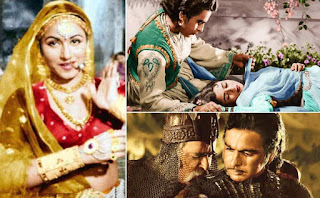The Filmfare reviewed Mughal-E -Azam at the time of its release on 5th Aug 1960, it is a tribute to the imagination, conviction, hard work, and lavishness of an extraordinary filmmaker K Asif.
The development of Mughal-e-Azam began in 1944 when Asif read a play set in the reign of Emperor Akbar He got a financer/producer Shiraz Ali Hakeem to make the movie. K Asif cast Chandra Mohan, D.K. Sapru, and Nargis for the roles of Akbar, Salim, and Anarkali, respectively..Shooting started in 1946 in Bombay Talkies studio. It is said four reels were shot. The political tensions and communal rioting surrounding India's 1947 partition and independence stalled production. Shortly after partition, Shiraz Ali migrated to Pakistan, leaving Asif without a financier.
The actor Chandra Mohan suffered a heart attack and died in 1949. Shiraz Ali had previously suggested that business tycoon Shapoorji Pallonji could finance the film. Although Pallonji knew nothing about film production, in 1950 he agreed to produce the film because of his interest in the history of Akbar. Production was then restarted with a new cast. Initially, K Asif rejected Dilip Kumar for the part of Prince Salim as he was too slim but later signed him for the role. For Akbar, the name of Prithviraj Kapoor was recommended by Shapoorji, and for the role of Anarkali the name of Suraiya was chosen but she refused the film. Ultimately Madhubala was signed for this role.
In 1952 K Asif began the shooting with the new cast. The music director now was Naushad, earlier it was Anil Biswas. Asif wanted to make the film on a grand scale, each set took 8 to 9 months to complete. It took 7 years to complete the film. Shahpoorji had full faith on Asif, he kept on pouring money for this film. Those days a normal film used to have a budget if 12-15 Lakh but this film was made on a budget of 1.5 crore rupees.
The film was sold for an astounding amount of 1.7 million per territory at a time when a big film used to be sold at 3 to 5 lakh per territory. There was a great euphoria related to this film. A grand premiere of this film was organized at Maratha Mandir theatre in Bombay'.All the top celebrities attended the premiere. In sync with the grandeur of the era, the film had set out to capture, invitations designed as a royal scroll and titled “ Akbarnama” were sent out to “command” the guests to arrive at the grand opening of the film.
. The film had an all-India release in 150 theatres simultaneously. This was a stupendous feat in those days. The film opened to largely positive reviews. It had captured the imagination of the viewers with its lavish scale, excellent performances, immortal dialogues, and soulful music. The film made a record collection 0f rupees 4 million by way of advance booking for the first week in Bombay only. Audiences queued up in front of theatres to see the film. Many stood and lived outside the theater for days. The demand for tickets of the
film forced the management to close ticket bookings for three weeks, “something that had never happened before—or since”.A rupees 1.30 ticket was sold in black for an amount as high as 200/-. Newspapers widely reported the success of the film and the mass hysteria amongst the audience.
Mughal-e-Azam became a mega-success and collected sales amounting to 35 million. It ran houseful in Maratha Mandir for three years, a record for Indian cinema which was broken after 15 years by Sholay in 1975.
Mughal-e-Azam garnered the position of a celluloid monument. On November 12, 2004, the film was re-released after fully coloring in theaters across India and history was all set to repeat itself.
Premiere of Mughal e Azam 1960
Song of Mughal e Azam 1960
Song of Mughal e Azam 1960
Song of Mughal e Azam 1960
Song of Mughal e Azam 1960
Song of Mughal e Azam 1960
Song of Mughal e Azam 1960
Song of Mughal e Azam 1960
Song of Mughal e Azam 1960
Song of Mughal e Azam 1960
Song of Mughal e Azam 1960






No comments:
Post a Comment